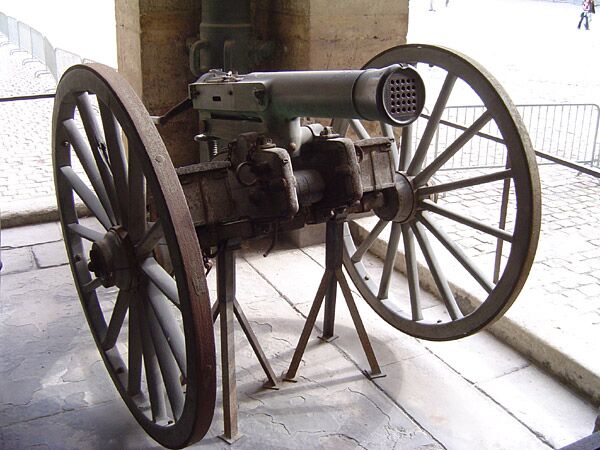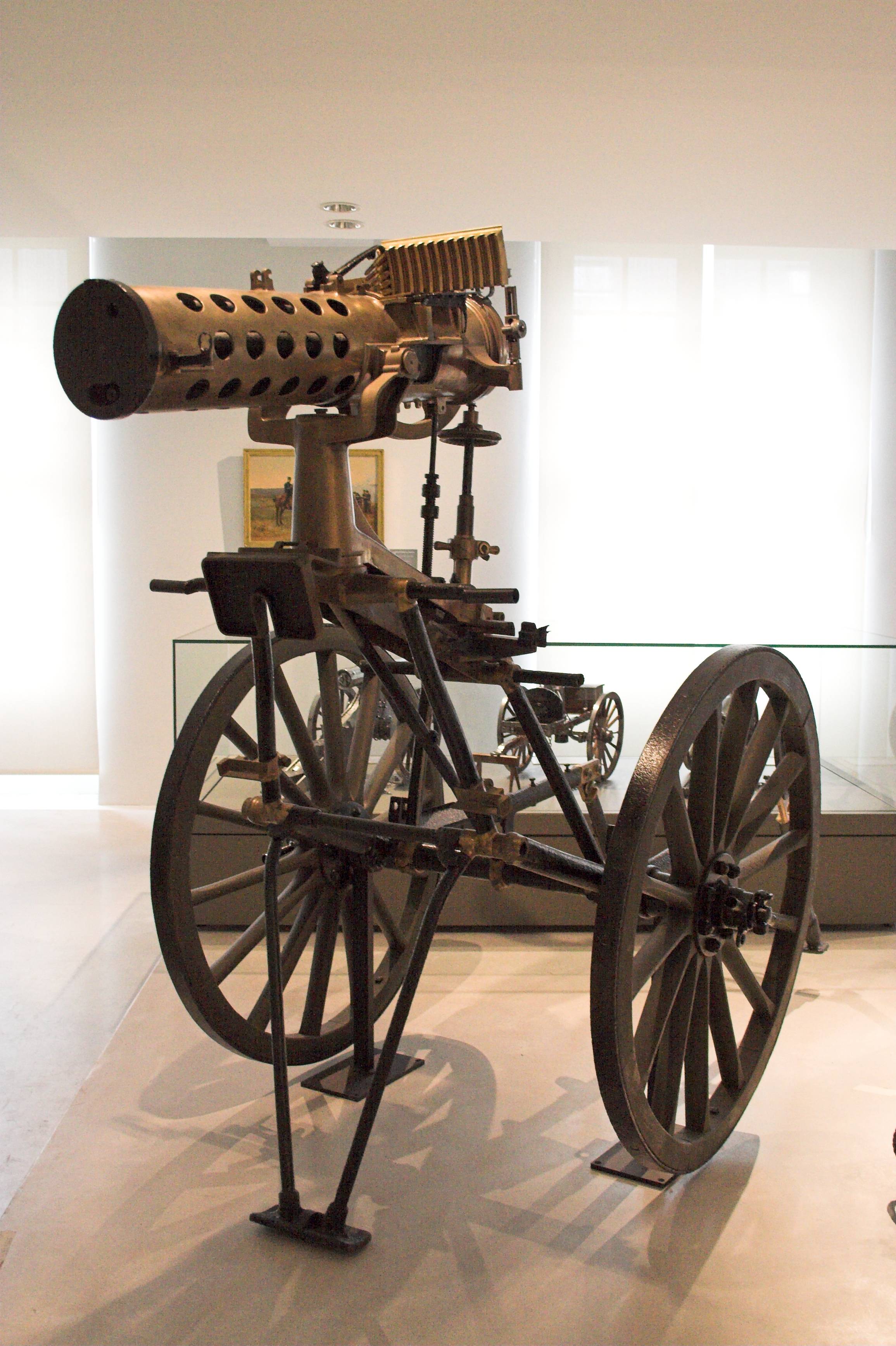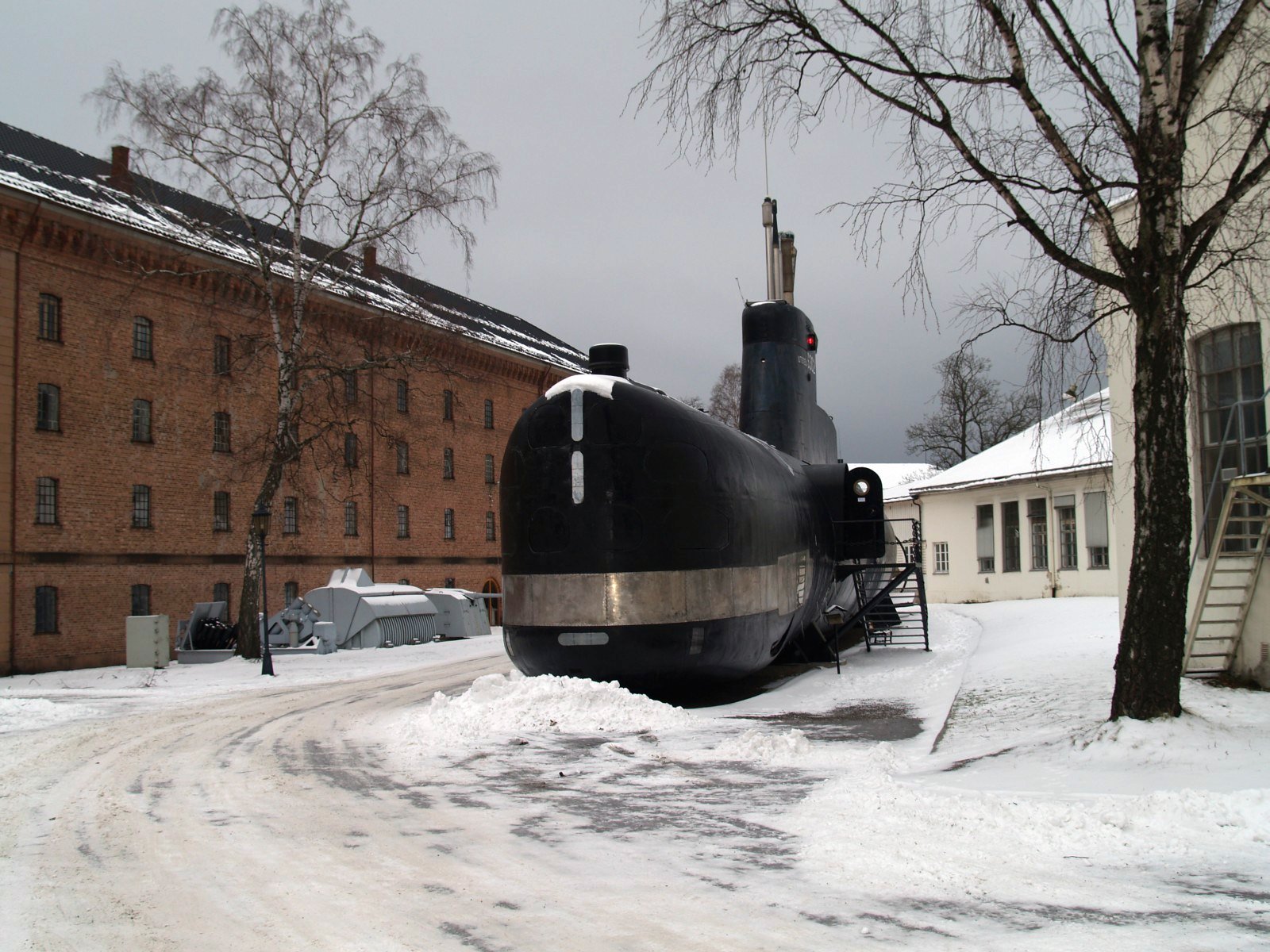|
1-inch Nordenfelt Gun
The 1-inch Nordenfelt gun was an early rapid-firing light gun intended to defend larger warships against the new small fast-moving torpedo boats in the late 1870s to the 1890s. Description The gun was an enlarged version of the successful rifle-calibre Nordenfelt hand-cranked "machine gun" designed by Helge Palmcrantz and was intended to combine its rapid rate of fire with a projectile capable of deterring attacking torpedo boats. The gun fired a solid steel bullet with hardened tip and brass jacket: under the terms of the St. Petersburg Declaration of 1868, exploding shells weighing less than 400 grams were not allowed to be used in warfare between the signatory nations. The gun was used in one, two and four-barrel versions. The ammunition was fed by gravity from a hopper above the breech subdivided into separate columns for each barrel. The gunner loaded and fired the multiple barrels by moving a lever on the right side of the gun forward and backwards. Pulling the lever ba ... [...More Info...] [...Related Items...] OR: [Wikipedia] [Google] [Baidu] |
Naval Gun
Naval artillery is artillery mounted on a warship, originally used only for naval warfare and then subsequently used for naval gunfire support, shore bombardment and anti-aircraft roles. The term generally refers to tube-launched projectile-firing weapons and excludes self-propelled projectiles such as torpedoes, rockets, and missiles and those simply dropped overboard such as depth charges and naval mines. Origins The idea of ship-borne artillery dates back to the classical era. Julius Caesar indicates the use of ship-borne catapults against Britons ashore in his ''Commentarii de Bello Gallico''. The dromons of the Byzantine Empire carried catapults and Greek fire, fire-throwers. From the late Middle Ages onwards, warships began to carry cannon, cannons of various calibres. The Mongol invasion of Java introduced cannons to be used in naval warfare (e.g. Cetbang by the Majapahit). The Battle of Arnemuiden, fought between England and France in 1338 at the start of the Hundred Y ... [...More Info...] [...Related Items...] OR: [Wikipedia] [Google] [Baidu] |
Helge Palmcrantz
Helge Palmcrantz (July 7, 1842 – November 22, 1880) was a Swedish inventor and industrialist. Biography Palmcrantz was born at Hammerdal in Jämtland, Sweden. He was the son of Per Gustaf Palmcrantz (1806–1905) and Lovisa Ulrika Nordenmark. His father was a captain in the Jämtland Ranger Regiment. He was enlisted as a cadet in his father's regiment, where he worked doing land surveying. After a couple of years he left the regiment to study at the Technological Institute of Stockholm, later known as KTH Royal Institute of Technology. In partnership with his brother-in-law, Theodor Winborg (1832–1918), Palmcrantz founded a small workshop on Vollmar Yxkullsgatan 25, Södermalm, Stockholm. As number of employees increased along with the production volume, he moved to a new factory on Kungsholmen, Stockholm, where they manufactured firearms, reaping machines, mowers and other agricultural equipment of their own design. The Palmcrantz factory, , would later be built on ... [...More Info...] [...Related Items...] OR: [Wikipedia] [Google] [Baidu] |
Torpedo Boat
A torpedo boat is a relatively small and fast naval ship designed to carry torpedoes into battle. The first designs were steam-powered craft dedicated to ramming enemy ships with explosive spar torpedoes. Later evolutions launched variants of self-propelled Whitehead torpedoes. These were inshore craft created to counter both the threat of battleships and other slow and heavily armed ships by using speed, agility, and powerful torpedoes, and the overwhelming expense of building a like number of capital ships to counter an enemy's. A swarm of expendable torpedo boats attacking en masse could overwhelm a larger ship's ability to fight them off using its large but cumbersome guns. A fleet of torpedo boats could pose a similar threat to an adversary's capital ships, albeit only in the coastal areas to which their small size and limited fuel load restricted them. The introduction of fast torpedo boats in the late 19th century was a serious concern to the era's naval strategists, i ... [...More Info...] [...Related Items...] OR: [Wikipedia] [Google] [Baidu] |
Volley Gun
A volley gun is a gun with multiple single-shot gun barrel, barrels that shoot projectiles in volley fire, either simultaneously or in succession. Although capable of unleashing intense firepower, volley guns differ from modern machine guns in that they lack Action (firearms)#Autoloading_operation, autoloading and automatic fire mechanisms, and therefore their volume of fire is limited by the number of barrels bundled together. In practice, large volley guns were not particularly more useful than a cannon firing canister shot or grapeshot. Since they were still mounted on a carriage, they could be as hard to aim and move around as a cannon, and the many barrels took as long or longer to reload.Matthew Sharpe "Nock's Volley Gun: A Fearful Discharge" ''American Rifleman'' December 2012 pp.50-53 They also tended to be relatively expensive since they were more complex than a cannon, due to all the barrels and ignition fuses, and each barrel had to be individually maintained and clea ... [...More Info...] [...Related Items...] OR: [Wikipedia] [Google] [Baidu] |
Gatling Gun
The Gatling gun is a rapid-firing multiple-barrel firearm invented in 1861 by Richard Jordan Gatling. It is an early machine gun and a forerunner of the modern electric motor-driven rotary cannon. The Gatling gun's operation centered on a cyclic multi-barrel design which facilitated cooling and synchronized the firing-reloading sequence. As the handwheel is cranked, the barrels rotate and each barrel sequentially loads a single cartridge from a top-mounted magazine, fires off the shot when it reaches a set position (usually at 4 o'clock), then ejects the spent casing out of the left side at the bottom, after which the barrel is empty and allowed to cool until rotated back to the top position and gravity-fed another new round. This configuration eliminated the need for a single reciprocating bolt design and allowed higher rates of fire to be achieved without the barrels overheating quickly. One of the best-known early rapid-fire firearms, the Gatling gun saw occasional use ... [...More Info...] [...Related Items...] OR: [Wikipedia] [Google] [Baidu] |
Machine Guns
A machine gun is a fully automatic, rifled autoloading firearm designed for sustained direct fire with rifle cartridges. Other automatic firearms such as automatic shotguns and automatic rifles (including assault rifles and battle rifles) are typically designed more for firing short bursts rather than continuous firepower, and are not considered true machine guns. As a class of military kinetic projectile weapon, machine guns are designed to be mainly used as infantry support weapons and generally used when attached to a bipod or tripod, a fixed mount or a heavy weapons platform for stability against recoils. Many machine guns also use belt feeding and open bolt operation, features not normally found on other infantry firearms. Machine guns can be further categorized as light machine guns, medium machine guns, heavy machine guns, general purpose machine guns and squad automatic weapons. Similar automatic firearms of caliber or more are classified as autocannons, rat ... [...More Info...] [...Related Items...] OR: [Wikipedia] [Google] [Baidu] |
Maxim Gun
The Maxim gun is a recoil-operated machine gun invented in 1884 by Hiram Stevens Maxim. It was the first fully automatic machine gun in the world. The Maxim gun has been called "the weapon most associated with imperial conquest" by historian Martin Gilbert, and was heavily used by colonial powers during the "Scramble for Africa". Afterwards, Maxim guns also saw extensive usage by different armies during the Russo-Japanese War, the First and Second World Wars, as well as by insurgent groups in contemporary conflicts. The Maxim gun was greatly influential in the development of machine guns, and it has multiple variants and derivatives. Design The Maxim gun featured one of the earliest recoil-operated firing systems in history. Energy from recoil acting on the breech block is used to eject each spent cartridge and insert the next one. Maxim's earliest designs used a 360-degree rotating cam to reverse the movement of the block, but this was later simplified to a toggle lock. T ... [...More Info...] [...Related Items...] OR: [Wikipedia] [Google] [Baidu] |
British Ordnance Terms
This article explains terms used for the British Armed Forces' ordnance (i.e.: weapons) and also ammunition. The terms may have slightly different meanings in the military of other countries. BD Between decks: applies to a naval gun mounting in which part of the rotating mass is below the deck, and part of it is above the deck. This allows for a lower profile of turret, meaning that turrets need not be superfiring (i.e. they can be mounted on the same deck and not obstruct each other at high angles of elevation.) BL The term BL, in its general sense, stood for breech loading, and contrasted with muzzle loading. The shell was loaded via the breech (i.e. the gunner's end of the barrel, which opened) followed by the propellant charge, and the breech mechanism was closed to seal the chamber. Breech loading, in its formal British ordnance sense, served to identify the gun as the type of rifled breechloading gun for which the powder charge was loaded in a silk or cloth bag and the br ... [...More Info...] [...Related Items...] OR: [Wikipedia] [Google] [Baidu] |
Chatham Historic Dockyard
The Historic Dockyard Chatham is a maritime museum on part of the site of the former royal/naval dockyard at Chatham in Kent, South East England. Chatham Dockyard covered 400 acres (1.6 km²) and was one of the Royal Navy's main facilities for several hundred years until it was closed in 1984. After closure the dockyard was divided into three sections. The easternmost basin was handed over to Medway Ports and is now a commercial port. Another slice was converted into a mixed commercial, residential and leisure development. 80 acres (324,000 m²), comprising the 18th-century core of the site, was transferred to a charity called the Chatham Historic Dockyard Trust and is now open as a visitor attraction. It claims to be the world’s most complete dockyard of the Age of Sail. Exhibits and displays The attraction has seven main elements: * Three historic warships: ** HMS ''Gannet'' (1878) ** HMS ''Cavalier'' (R73) ** HMS ''Ocelot'' (S17) * The Ropery: a Grade I liste ... [...More Info...] [...Related Items...] OR: [Wikipedia] [Google] [Baidu] |
Royal Norwegian Navy Museum
The Royal Norwegian Navy Museum (Norwegian: ''Marinemuseet'') is a museum documenting the history of the Royal Norwegian Navy. It is located at the former main naval base of Karljohansvern in Horten. The museum was founded by C.F. Klinck on 24 August 1853. The museum is sometimes regarded as the world's first naval museum, as it was the first collection of naval memorabilia open to the public. The collection The collection contains several decommissioned ships, much equipment used by the Norwegian, Allied and German navies and ship models, paintings and pictures. In the 1980s the Royal Norwegian Navy Library was transferred to the museum. The library's book collection started in 1805. The Museum and Library have a book collection of about 25,000 volumes. In addition the museum has preserved all of the navy's ship log books from 1814 to today. Parts of the Museum was however destroyed during an allied bombing raid on Horten in February 1945. The museum also preserves ship designs a ... [...More Info...] [...Related Items...] OR: [Wikipedia] [Google] [Baidu] |









